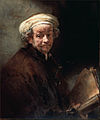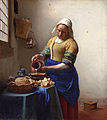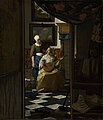Rijksmuseum
 Gmach Rijksmuseum | |
| Państwo | |
|---|---|
| Miejscowość | |
| Adres | Postbus 74888 |
| Dyrektor | Prof. Ronald de Leeuw |
| Strona internetowa | |
Rijksmuseum (hol. Muzeum Państwowe) – holenderskie muzeum narodowe w Amsterdamie na Museumplein; jedna z głównych atrakcji turystycznych tego miasta.
Wśród zbiorów Rijksmuseum znajdują się nie tylko cenne dzieła malarskie, lecz także grafiki, rzeźba, sztuka użytkowa i rękodzieło. Kolekcja malarstwa to ponad 5 tysięcy obrazów reprezentujących malarstwo holenderskie i światowe XV-XIX wieku. Kolekcja malarstwa zawiera dzieła takich malarzy jak: Jacob van Ruisdael, Frans Hals, Johannes Vermeer, Rembrandt i uczniów Rembrandta. Ważna jest także kolekcja sztuki azjatyckiej.
Muzeum, pod nazwą Nationale Kunst-Gallerij, powstało w 1800 w Hadze, a w 1808 zostało przeniesione do Amsterdamu. Dokonał tego król Ludwik Napoleon, brat Napoleona Bonapartego. Obrazy takie jak np. Wymarsz strzelców Rembrandta, które były własnością miasta, weszły w skład kolekcji muzeum (obraz ten znajduje się w osobnej sali od roku 1906).
W 1885 muzeum przeniesiono do obecnej siedziby, wybudowanej przez holenderskiego architekta Pierre'a Cuypersa, która łączyła elementy architektury gotyckiej i renesansowej. Muzeum zajmuje główne miejsce na Museumplein w pobliżu Muzeum Vincenta van Gogha i Stedelijk Museum.
Niektóre obrazy z kolekcji Rijksmuseum
Rembrandt van Rijn
Żydowska narzeczona (ok. 1665)
Jan Vermeer
Mleczarka (ok. 1660)
Uliczka (1657-1658)
Kobieta w błękitnej sukni (ok. 1663-1664)
List miłosny (ok. 1669)
Frans Hals
Jan Willem Pieneman
Hendrik Voogd
Linki zewnętrzne
- ISNI: 0000 0001 2196 1335, 0000 0004 0369 6779
- VIAF: 159624082
- ULAN: 500246547
- LCCN: n79007489
- GND: 1009452-0
- NDL: 00628115
- BnF: 118670598
- SUDOC: 026420066, 030383277
- SBN: CFIV017976
- NLA: 36126463
- NKC: kn20050504027
- BNE: XX144298
- BIBSYS: 90075408
- CiNii: DA03073270
- PLWABN: 9810608129005606
- NUKAT: n98068736
- J9U: 987007266995505171
- CANTIC: a11035651
- NSK: 000051621
- LIH: LNB:V*110486;=BG
- WorldCat: lccn-n79007489
Media użyte na tej stronie
Frans Banning Cocq, heer van purmerlant en Ilpendam, Capiteijn Willem van Ruijtenburch van Vlaerdingen, heer van Vlaerdingen, Luijtenant, Jan Visscher Cornelisen Vaendrich, Rombout Kemp Sergeant, Reijnier Engelen Sergeant, Barent Harmansen, Jan Adriaensen Keyser, Elbert Willemsen, Musketier Jan Clasen Leydeckers (behind the Lieutenant in Yellow blowing into the powder pan of a musket which once belonged to Jan Snedeker), Jan Ockersen, Jan Pietersen bronchorst, Harman Iacobsen wormskerck, Jacob Dirksen de Roy (the Governor on far left of the cut off section of the painting), Jan vander heede, Walich Schellingwou, Jan brugman, Claes van Cruysbergen, Paulus Schoonhoven
Autor: Dr. Blofeld, Licencja: CC BY-SA 2.0
Map of Amsterdam
Geographic limits of the map:
- N: 52.496°
- S:52.247°
- W: 4.699°
- E: 5.125°
- Wolno:
- dzielić się – kopiować, rozpowszechniać, odtwarzać i wykonywać utwór
- modyfikować – tworzyć utwory zależne
- Na następujących warunkach:
- uznanie autorstwa – musisz określić autorstwo utworu, podać link do licencji, a także wskazać czy utwór został zmieniony. Możesz to zrobić w każdy rozsądny sposób, o ile nie będzie to sugerować, że licencjodawca popiera Ciebie lub Twoje użycie utworu.
- na tych samych warunkach – Jeśli zmienia się lub przekształca niniejszy utwór, lub tworzy inny na jego podstawie, można rozpowszechniać powstały w ten sposób nowy utwór tylko na podstawie tej samej lub podobnej licencji.




















































